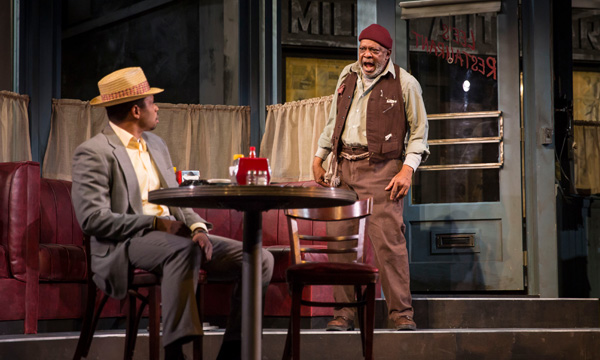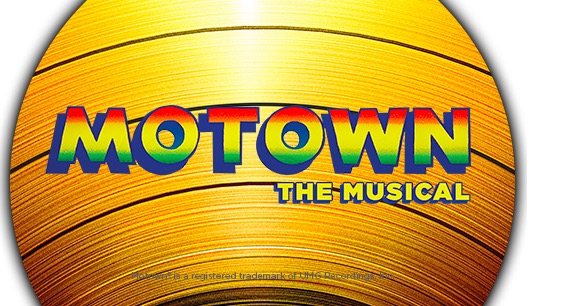

Features
Are There Still Only Two Trains Running? A Talk With Ernest Perry Jr. & Chester Gregory
Published
11 years agoon
We had the privilege of talking with two dynamic actors who were recently a part of the cast of Two Trains Running by August Wilson at The Goodman Theatre in Chicago that closed Sunday April 19th, which we told you NOT to miss! One was Ernest Perry Jr., who is a veteran and a staple in the Chicago theatre scene, having worked on 8 out of 10 August Wilson cycle pieces in the course of his career, shared with us a lot of history and wisdom from his years. The other was the astounding Chester Gregory, who took the Wilson journey for the first time with Two Trains. Some of the insight they had caused a stir in us. Hopefully it’ll do something for you as well.
Now, I interviewed these two gentlemen over two weeks ago, before there were the stories of #EricHarris and #WalterScott flooding all of our news sources. The images and the video from those high profile stories and the thought of there being cases we know nothing about made me take the time to really listen to what these two gentlemen had to say about the stage our country is on/in and how much August Wilson really knew about the reality of the world then and what we were facing.
“August Wilson is one of our great American playwrights. As an actor it isn’t very often you get dialogue this rich.” says Gregory “I wanted to really get a chance to live in the world and in the language of Wilson.” He also goes on to talk about how the entire show was blocked in 3 days so they could really focus on living the words and even though it’s taking place in 1969, and the first production was mounted in 1990, it felt very relevant to 2015. “Civil rights, racism, the relationships black men have with the police, the struggle to find good work, protests and rallies, there’s a lot of information that is poignant for today. It feels like he wrote it in the past year but that’s why it’s a classic piece because it’s just that timeless. But hopefully 20 years from now it will resonate in a different way.”
Chester Gregory portrayed Sterling. A personable young man who appears to be somewhat “unbalanced,” Sterling has recently been released from jail. He does not show any remorse for his crime, which was robbing a bank because he was tired of having no money, and he seems poised to go back to prison. The play suggests that work is very difficult to find for poor black people, and Sterling continually looks in vain for a job.
Ernest Perry Jr., who portrayed Hambone in this production of Two Trains talks about how his character has a special significance. Even though Hambone has a physical impairment it doesn’t effect his mental capacity and that a lot of time we dismiss people like him because of the way we perceive them. This character represents us as a people, in a way. No matter how someone may think of us, that doesn’t distract us from our mission of justice and equality.
The Hambone story line is based upon the white owner of the meat market who promised to reward Hambone with a ham if he painted his fence well, but then agreed only to give him a chicken. Hambone repeats the same phrase of wanting his Ham over and over again. He wants and deserves what is owed to him and will not focus on anything else but that.
“That’s why he says “I want my ham. He’s going to give me my ham” because until he is compensated for the work he has already done he’s not going to focus on anything else. And that’s the way we have to be, and some of us are, as a people. Which is the reason African-Americans have accomplished so much because we have that type of attitude today. You’re going to give us our due!” – Ernest Perry Jr.
To be honest, listening to this interview back the first time, I understood but I really didn’t get it. It wasn’t until I woke up to the story of #WalterScott and thought about some the things that were said here that it stung me. I just began to cry and couldn’t revisit it until now. I understood what Chester Gregory felt when he told me about his on stage experience in sharing this story. In how he felt the realization of telling someone else’s story, that it was lived. That someone actually lived the life of being a janitor locked inside of a building overnight to clean and let out in the morning only to make sure they didn’t steal anything. The pain of knowing an injustice, even if you’re unaware of anything else, just wraps itself around you like a boa constrictor and chokes the hell out of your soul.
“Look, is there any difference between what Wilson was writing about in 1969 and today? Every line could really be taken out of today’s headline. The whole thing. Everything is still relevant. That’s why it’s very difficult to believe that we’ve made any real progress or any change. So you have to ask yourself where is the progress if we’re still dealing with the same problems?” says Perry. Then he leaves us with this. “You’ve got to roll up your sleeves and get to work because there is so much work to be done. We’re all human beings and we’re so far away from that concept of being human beings to and with one another. Yeah, they’re not hanging us up in the trees but they’re singing songs about it on a bus. And if we don’t realize our common humanity we will all perish.”
“There are always and only two trains running. There is life and there is death. Each of us rides them both. To live life with dignity, to celebrate and accept responsibility for your presence in the world is all that can be asked of anyone.”
―August Wilson
Broadway star and Gary, IN native Chester Gregory appears in his very first August Wilson play—Two Trains Running, directed by Chuck Smith, in the role of Sterling—at Goodman Theatre, where he previously appeared in Regina Taylor’s Drowning Crow (2002). His Broadway credits include Hairspray, Tarzan, Cry-Baby and Sister Act and has received an NAACP Theater Award for his performance as Jimmy Early in the national tour of Dreamgirls; his performance in The Jackie Wilson Story earned him a Joseph Jefferson Award, Audelco Award, Black Theatre Alliance Award (BTAA) and Black Excellence Award. Mr. Gregory toured his one-man show, The Eve of Jackie (Wilson), at venues across the country, including in his hometown—where he was presented with the key to the city and made an Honorary State Representative. He will receive an honorary doctorate from Columbia College Chicago this spring.
Critical acclaim for Chester Gregory in Two Trains Running
“A grand return from Broadway” –Chicago Sun-Times
“Endearing, dynamic” –Daily Herald
“Gregory imbues Sterling with charm and potential” –Chicago Critic
Founder/Editor-In-Chief of BroadwayBlack.com | Actor | Artist | 1/3 of @OffBookPodcast | Theatre connoisseur | All Audra Everything | Caroline over Change | I'm Not Charl Brown | Norm Lewis is my play cousin | Producing an all-black production of Mame starring Jenifer Lewis in my head

You may like
Features
Photo Exclusive: Step into The Light with Broadway Black
Published
7 years agoon
February 21, 2019
Have you seen The Light by Loy A. Webb at MCC Theater? If you haven’t, then you need to and Broadway Black has got you. Join us on SUNDAY MARCH 3rd for the BWAYBLK Experience!
Use code BWAYBLACKMCC and pay $35 for any seat on Mar 3 at the 7:30 performance
Not every marriage proposal goes as planned. LOY A. WEBB’s THE LIGHT introduces us to RASHAD and GENESIS on what should be one of the happiest days of their lives, but their joy quickly unravels when ground-shifting accusations from the past resurface in this gripping two-character drama. Can their relationship survive the growing divide between them over who–and what–to believe?
Also, get into this amazing photo series of playwright Loy A. Webb & the cast of her play The Light. Photos by Curtis Brown were taken in the new elegantly designed and strategically welcoming Robert W. Wilson MCC theater space. Located in midtown New York on 52nd and 10th ave (511 W 52nd ST
New York, NY 10019)
On another tip, some really dope creatives will do a talkback after the Saturday matinee performance that you might be interested in attending. Make sure to RSVP.
Panelists include: Nissy Aya, Cristina Pitter, Alicia Rodis & Kavita Mehra
THIS WEEKEND SAT FEB 23rd
LOY A. WEBB’s THE LIGHT at MCC Theater delves deeply into one couples’ reckoning with an encounter with sexual violence that has left audiences asking: as a partner, a family member, a friend, how do we support sexual assault survivors? And what responsibility do artists have to create work that is trauma-informed? On SAT FEB 23 at 4:00 PM for an in-depth conversation about the power of allyship rooted in love and healing – in our lives and on our stages – in the face of trauma.
SAT FEB 23 at 4PM
THE ROBERT W. WILSON MCC THEATER SPACE
511 W52 ST
RSVP HERE.
Features
A Superhero On & Off The Stage, Camille A. Brown Brings ink
Published
7 years agoon
February 5, 2019

Camille A. Brown Photo by Whitney Browne
Camille A. Brown‘s dance company, Camille A. Brown & Dancers, tours nationally and internationally and will be presenting six performances featuring the debut of ink at The Joyce Theater NYC Feb 5-10th 2019.
Propelled by the live rhythms and sounds of traditional African and handmade instruments, Camille A. Brown’s ink celebrates the rituals, gestures, and traditions of the African diaspora. Highlighting themes of brotherhood, community, and resilience, the work seeks to reclaim African American narratives and is the final installment of Brown’s dance theater trilogy about identity.
In addition to her company works, Ms. Brown brings her passion for storytelling to her award-winning choreography for Broadway, Television, and Off-Broadway. Productions include Tony Award Winning Once On This Island, (Drama Desk, Outer Critics and Chita Rivera award nominations), Emmy Award Winning Jesus Christ Superstar Live on NBC, A Streetcar Named Desire, Choir Boy, the upcoming Magic Mike The Musical, PAL JOEY.
We had the chance to probe a little bit into the world of Camille A. Brown, and we’re grateful for the insight and wisdom with which she was able to bless us. Check out the interview below along with an excerpt from ink.
Broadway Black (BB): After forming the idea, what was the process of building ink?
Camille A. Brown (CAB): After the creative process for BLACK GIRL: Linguistic Play, I held a desire to dig even deeper and tell more stories of ritual, gestural vocabulary, and traditions of the African Diaspora. I was immediately drawn to two albums that had a significant impact on me when I was growing up. The Miseducation of Lauryn Hill by Lauryn Hill, and Like Water for Chocolate by Common. I tasked myself with creating a movement language that embodied the same raw authenticity, and vulnerability that fuels those lyrics and music.
As I began to develop the concept for ink, I wanted the dancers to represent superheroes. I couldn’t figure out why I had the urge to play with this idea until I read Question Bridge: Black Males in America. One of the men interviewed said, “I see Black people as comic book heroes because they always keep rising.” That was it! It is about showing that in our basic survival, and natural attributes we have superhuman powers. Powers to shift, overcome, transform, and persevere even within an often hostile environment. The seven sections of ink represent super powers of spirituality, history and heritage, the celebration of the Black female body, Black love, brotherhood, exhaustion, and community.
The process involves a deep collaboration with the dancers and my direction is guided by their choice making.
The space is very organic and fueled by research. My dancers, musicians, dramaturgs, and I are in constant dialogue throughout the process about the work and how it’s progressing. We don’t move forward unless we’re all on the same page.
We are building the work together. As a disclaimer, I let everyone know the process will be exceptionally tedious. Like a fine comb, I go through each beat, gage the temperature of storylines, and make sure the movement and music are always in conversation (whether aligned or in contrast).
BB: What made you want to start your own dance company and how have you sustained?
CAB: I found my love of choreography in college because I struggled with body image, and found that creating my own voice was a safe and empowering space. After graduating, I danced with Ronald K. Brown/Evidence for 5 seasons and during my second year with The Company, a friend from college (Amy Page) sent me a flyer for the Hubbard Street 2 competition which picks 3 choreographers to create work on the Company. I was chosen! That gave me the encouragement to pursue choreography. My first idea was to take an alias like female writers used to do because even at 22, I knew the playing field was not leveled and women (particularly black women) did not get as much exposure as male choreographers. Dance is revealing and vulnerable so taking an alias wasn’t a realistic option. People would have to see me as I am, but I also needed the confidence to withstand the obstacles. Not only that, having a company seemed daunting.
Ron wore so many hats. He was the director, choreographer, teacher, and also took on administrative duties. He never got a break. I wasn’t confident I could handle all of the duties.
I set work on other companies, but soon realized it wasn’t for me. 1-4 weeks working with a Company wasn’t enough time for me to really hone my skills, find my voice, and discover my personal creative process. I desired a more intimate relationship and space with my dancers and collaborators. I had my first show at Joyce SoHo in 2006, and committed to having a company in 2010.
What sustains CABD is my team. I have a company agent (Pamela Green), Managing Director (Indira Goodwine), Company Manager (Michelle Fletcher), and a production team who holds things down.
In the beginning, I was doing ALL the jobs! As time went on, my team slowly formed. It’s really about patience and perseverance. Nothing happened over night and everything is a progression.
BB: How have you had to be a superhero in your own life personally and professionally?
CAB:
Personally
Last year, I had a life-threatening experience. My appendix ruptured on tour. Appendicitis is when they remove your appendix before it ruptures, but mine actually did and the fluid was in my system for at least a week. I survived the “fatal” stage- which the doctors told me isn’t common. This started a very long year and a half which included 4 hospital stints and two surgeries (my second one was in April). This all happened during Once on This Island (I was in the hospital the first week of rehearsal and had my first surgery during tech), Jesus Christ Superstar Live, and my Company touring. I had to access my “superpowers” and push through, but thankfully I had my team and community to help me.
I’m going to be writing about the entire ordeal because it was such an integral part of my life. People see the “success”, but if they only knew the hardships I had to overcome to get to the other side.
Professionally
Being a Black female Choreographer and Director is hard. People ask me to do I feel like I’ve arrived. Absolutely not. I’m still Black and a woman- two underrepresented groups- particularly in theater. The playing field is still not leveled and I’m clear I have to work twice as hard.
I’ve had to build up strength and confidence. It is an ongoing process of gathering those superpowers. In many spaces, I’m sometimes the only woman (I was the only woman on the creative team for Jesus Christ Superstar Live), and the only black person in some rooms.
Recently two black girls at different events asked me the same exact question: How do you navigate spaces where you’re the only one.
It’s quite easy to feel intimated and shrink yourself. I know I have done that in the past. Now, I’ve found if I think about the black women before me in similar spaces, black women who are currently in similar spaces, and the next generation of black women coming after me, it makes me more confident. When it’s not just about you, it becomes a responsibility.
And even when I don’t feel like I have any superpowers, this happens…
and it refuels and encourages me to keep going. Someone is always watching.














